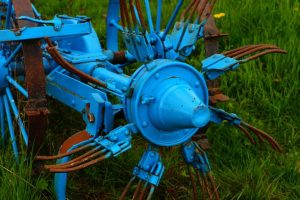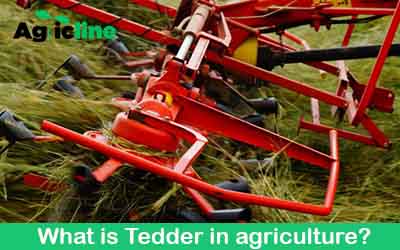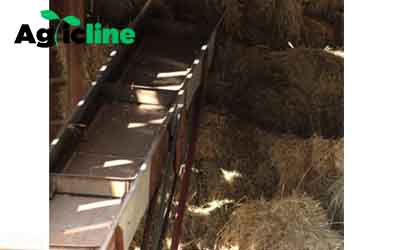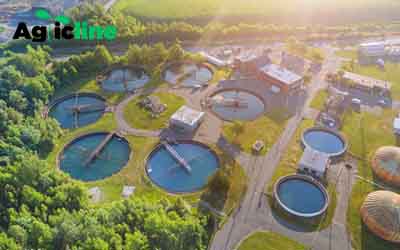In agriculture, a tedder is a piece of equipment used for haymaking and forage harvesting. It is designed to spread and turn the cut grass or forage crop, facilitating the drying process.
A tedder helps to expose the material to air and sunlight, allowing for faster and more even drying.
Tedding is an important step in haymaking and forage harvesting operations. It helps to achieve higher-quality hay or forage by promoting even drying, reducing the risk of mold or fermentation, and preserving nutrient content.
A properly tedded crop can result in better overall forage quality, increased storage stability, and improved feed value for livestock.
Overall, tedders play a crucial role in the haymaking process, ensuring efficient drying and optimal forage quality for livestock feeding or storage.
Feature of tedder
Here are some key features and functions of a tedder:
- Tines or Rotors: A tedder consists of multiple rotating tines or rotors, typically made of metal, mounted on a central rotor shaft. The tines are angled and arranged in a spiral pattern to pick up and spread the cut material.
- Spreading Action: As the tedder moves through the field, the rotating tines lift and separate the cut grass or forage crop. The tines gently toss the material into the air, spreading it evenly across the field. This action helps to prevent the formation of dense windrows and allows for better airflow and drying.
- Adjustable Height and Angle: Tedders often have adjustable height settings to accommodate different crop heights and desired tedding intensity. The angle of the tines can also be adjusted to control the spread pattern and optimize drying conditions.
- PTO Driven: Tedders are typically powered by a tractor’s power take-off (PTO). The PTO transfers power from the tractor to the tedder’s rotating shaft, which, in turn, drives the tines.
- Working Width: Tedders come in various working widths, ranging from a few feet to several meters. The working width determines the coverage area and affects the productivity of the tedding operation.
- Maneuverability: Tedders are commonly attached to the three-point hitch of a tractor. This allows for easy maneuvering and adjustment while operating in the field. Some tedders may also have transport wheels for convenient movement between fields or storage.
- Time Efficiency: Tedding helps to speed up the drying process by exposing the cut material to air and sunlight. By spreading and turning the grass or forage crop, a tedder can reduce drying time, minimizing the risk of spoilage or nutrient loss.

Functions of tedders
The primary function of a tedder in agriculture is to facilitate the drying process of cut grass or forage crops.
Spreading and Aerating
A tedder spreads and turns the cut material, such as grass or forage crops, across the field. By lifting and tossing the material into the air, it helps to separate the layers and create a loose and aerated arrangement.
This spreading action exposes a larger surface area of the material to air and sunlight, promoting faster and more even drying.
Enhanced Drying
By spreading the cut material, a tedder allows for improved airflow and sunlight penetration. This leads to faster moisture evaporation, reducing the drying time of the crop. Proper drying is essential for preserving the nutritional value of the forage and preventing the growth of mold or mildew.
Uniform Drying
A tedder helps achieve uniform drying throughout the harvested crop. By turning and spreading the material evenly, it minimizes the formation of dense windrows or clumps that could retain moisture and impede drying. This promotes consistency in forage quality and reduces the risk of spoilage.
Preservation of Nutrient Content
Quick and efficient drying facilitated by a tedder helps to preserve the nutrient content of the cut material.
By reducing the exposure to moisture, the risk of nutrient loss or degradation is minimized. This is particularly important for maintaining high-quality forage for livestock feed.
Time Efficiency
Tedding can significantly reduce the drying time of the harvested crop. Faster drying allows farmers to collect the forage more quickly, reducing the risk of weather-related damage and ensuring timely harvests. It also enables farmers to maximize their haymaking operations during favorable weather conditions.
Improved Forage Quality
The proper use of a tedder contributes to better overall forage quality. The combination of uniform drying, preservation of nutrients, and reduced risk of spoilage helps to produce high-quality hay or forage with optimal nutritional value and palatability for livestock.
Versatility
Tedders are versatile machines that can be used in various types of forage crops, including grasses, legumes, and other hay crops. They can be adjusted to different working widths, allowing farmers to adapt to different field sizes and conditions.

A final thought about tedder
In the realm of agricultural equipment, a tedder plays a crucial role in the haymaking and forage harvesting process.
By effectively spreading and turning the cut material, it expedites the drying process, enhances forage quality, and contributes to efficient farming operations. Tedding helps to minimize the risk of spoilage, preserve nutrient content, and ensure a more uniform and consistent drying across the field.
The use of a tedder empowers farmers to optimize their haymaking activities, capitalize on favorable weather conditions, and achieve higher yields of high-quality forage.
It is a versatile tool that can be adjusted to different working widths and adapted to various types of forage crops. With its ability to improve drying efficiency and preserve nutritional value, a tedder is an indispensable asset for farmers seeking to optimize forage production and provide nutritious feed for their livestock.
By investing in a quality tedder and employing proper tedding techniques, farmers can significantly enhance their haymaking operations, reduce potential losses, and ultimately contribute to the overall success of their agricultural endeavors.



